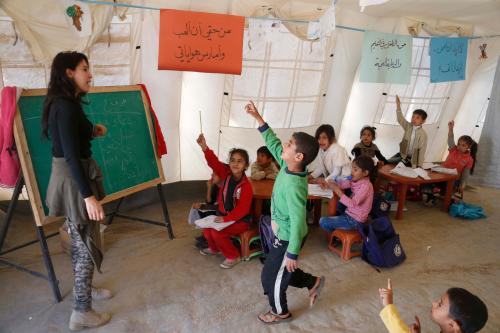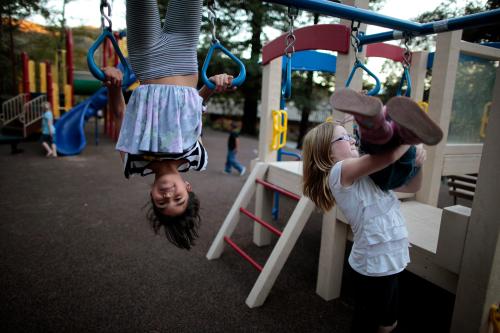The U.S. scores below many industrialized nations in rates of child poverty, lagging behind France, Hungary, and Chile, among others. Dramatically different social safety net and health care systems, population diversity, economic and political stability, and capitalist society values with purported opportunities are only a few of the many explanations for the disparities that play uniquely into the U.S. child poverty experience. Hovering at about 1 in every 5 children residing at or below the federal poverty threshold, U.S. child poverty has not substantially budged in the last 50 years. Even though the U.S. has made some headway in reducing socio-economic and racial/ethnic gaps in outcomes such as educational achievement, gaps remain and new ones are emerging in areas such as infant birth outcomes and household wealth. Especially striking—and, in conflict with American principles—is the documented relationships between zip code (where you are born or live) and children’s outcomes.
It is in this context that findings from a recent randomized study in Seattle were greeted with incredible fanfare; economist Raj Chetty called it “… the largest effect I’ve ever seen in a social science intervention.” The study found that the share of families moving to high-opportunity neighborhoods increased from 14 to 54 percent after offering families a housing voucher and counseling to navigate the housing market. News reports further touted that “if it can be replicated at scale, the experimenters may have hit on a powerful new tool for dismantling residential segregation in the United States.” Indeed high-opportunity neighborhoods defined as safe and springboards for economic success are good for families and for children. Not only do they reduce everyday stressors through activities like walking outside to get to school or work but also offer proposed gateways to higher quality schools and networks for stable employment. Beyond housing’s value at a neighborhood level, it provides the core need for stability not to mention practical benefits (think of all the times you have to put your address down for something). On the surface then, the celebration over the Seattle study appears merited.
Or, does it?
Can moving families to high-opportunity neighborhoods create the kind of panacea that better prepares children in the short- or long-run? Questions loom whether this type of experiment is scalable, and further whether it is sustainable, a question that consumes scholars and policymakers. Then there is the implicit issue of whether providing families with housing vouchers (a type of “conditional cash”) will help as they navigate the paperwork for a new home and life (a type of counseling or direct services). Is “moving to opportunity” going to help children escape the very real and often enduring impacts of poverty and racial disparities?
For young children, unequal opportunity starts even before they are born with poorer health care options and nutrition. By just 5 weeks of age, research from Laura Betancourt and her colleagues report that there are differences in brain volume and grey matter. Using their words, “biological embedding of adversity may occur very early in development.” Neuroscientist and pediatrician Kimberly Noble similarly finds variation in very early brain development by household income and stresses that “the brain is not destiny.”
The promise of early childhood education
Within early education, researchers and social service providers have applied light touch, low cost, or even distance programs like text-based curricula that have shown positive effects for both parents and children. Others commit to higher level investments such as universal pre-K starting at age 3. Thus far, the news on the high-quality programs, including text-based strategies, has been generally positive. Indeed, Nobel Laureate James Heckman of the University of Chicago reports that certain types of high-quality birth to age five programs for economically disadvantaged children can deliver a 13% per child, per year, return on investment. But it is important to note that even here, some barriers remain. If the early education programs are not high quality, they do not produce the intended results, and most programs still fall short of meeting the quality bar. Other barriers to success include “supply side stickiness” like child care deserts and a tired and under-supported provider workforce. Further, policymakers assume that all families will rush to sign up for, and use, early childhood information and programs as long as they are available to them. The data show, however, that full engagement is rare, even for the most well-resourced programs.
Of course, no one policy solution is likely to solve the seemingly intractable problem of childhood poverty. Even if all children were enrolled in high-quality, early care education programs, they often return to home and neighborhood environments that are under-resourced and demanding in ways that counterbalance or even undo the benefits of high-quality care and education.
To succeed, “moving on up” needs to be more than “moving to opportunity.” It is beyond time to look for policy solutions that can tackle child poverty systemically, and to invest in infrastructure while simultaneously dealing with systemic change.
Parents as mechanisms of change
The Seattle study points to neighborhoods as the key opportunity barrier, and the experiment offers one pathway for changing resources for parents and caregivers. The logic is that, with relocation efforts, parents should encounter fewer barriers for themselves and their children in their new environment. With a stable address and place to sleep, and less energy to have to devote to keeping children safe, more attention can be invested in children. The Seattle study shows that when parents are guided with information and offered financial resources, they are responsive to opportunities to move to better housing and better neighborhoods, aspects of children’s environments that predict their future outcomes.
This approach complements what we see in early childhood education by harnessing parents as a mechanism of change. The Seattle study does this by promoting parent-directed relocation. A variety of other types of conditional benefits embrace the same (rational) logic: If parents do X, then they will get Y. The Earned Income Tax Credit is a great example: Families receive a generous tax refund based on earnings adjusted for family size. These types of policies show some success but similar to the possible issues with relocation, a family’s capacity to harness the benefits is constrained by availability and by their capacity to take advantage of the offering. In other words, it is difficult to take advantage of an earned income tax credit if the job market is constrained or if filing for taxes is not easy. To its credit, the Seattle study tried to tackle issues like this with family-navigators—or coaches to help with things like filling out rental applications and search for housing. But this still assumes that a housing market exists to absorb those choices, and that those destination homes and neighborhoods will remain opportunity destinations.
Reaching families in existing circumstances
What other policy solutions can harness parents and families as mechanisms of change within existing circumstances? One alternative is to give families more money. Money allows families to navigate existing infrastructure and resources in ways that they see as beneficial and in ways that can be responsive to changing circumstances such as when high opportunity neighborhoods begin to crumble. How unconditional cash can affect families during the most sensitive years of their children’s early development is currently being tested in the U.S. Social scientists and neuroscientists are teaming up on a multi-site randomized control study to see how a monthly cash gift for the first 40 months of a child’s life affects subsequent brain development. The team is also tracking how this type of strategy might be an avenue for families to relocate to high opportunity neighborhoods on their own terms.
Another alternative is to think big and creatively about how to reach parents and support their good intentions. With no single streamlined pipeline or platform to reach families of very young children, this means bridging across places, technologies, and services, such as pediatric offices, early care and education providers, playgrounds and super markets, and connecting through tools like smart phones and social media. Can social service offices like the Women, Infant, and Children feeding program be reconfigured more generally as early education, care, and parent support one-stop shops in the ways that employment programs have evolved? Can the default design of supermarkets and playgrounds seamlessly bake in parenting tips about childhood development like it is being tested by Too Small to Fail, Vroom, and Playground Learning Landscapes?
Systemic change also means looking hard at infrastructure and whether systems treat families equitably. People of color, immigrants, and disabled parents face unique and historical barriers that require both top down and bottom up restructuring. Even with unbridled resources, information, and access, it would be naïve to assume that parents can enact change in equitable ways.
Poverty can have enduring negative impacts on children that stretch to future generations. The Seattle study highlights a relatively new spin on a relocation strategy that seems promising. Can it succeed without acting in concert with other approaches like early high-quality education, cash transfers, and infrastructure investments if the goal is to offer a way out for the next generation of children born into poverty? The good news is that science and policy has already made some headway as single-pronged approaches. To genuinely alter children’s prospects, what we really need is a multi-pronged, coordinated set of policy investments that enable each child to fully reach her potential.








Commentary
Moving on up: More than relocation as a path out of child poverty
October 17, 2019